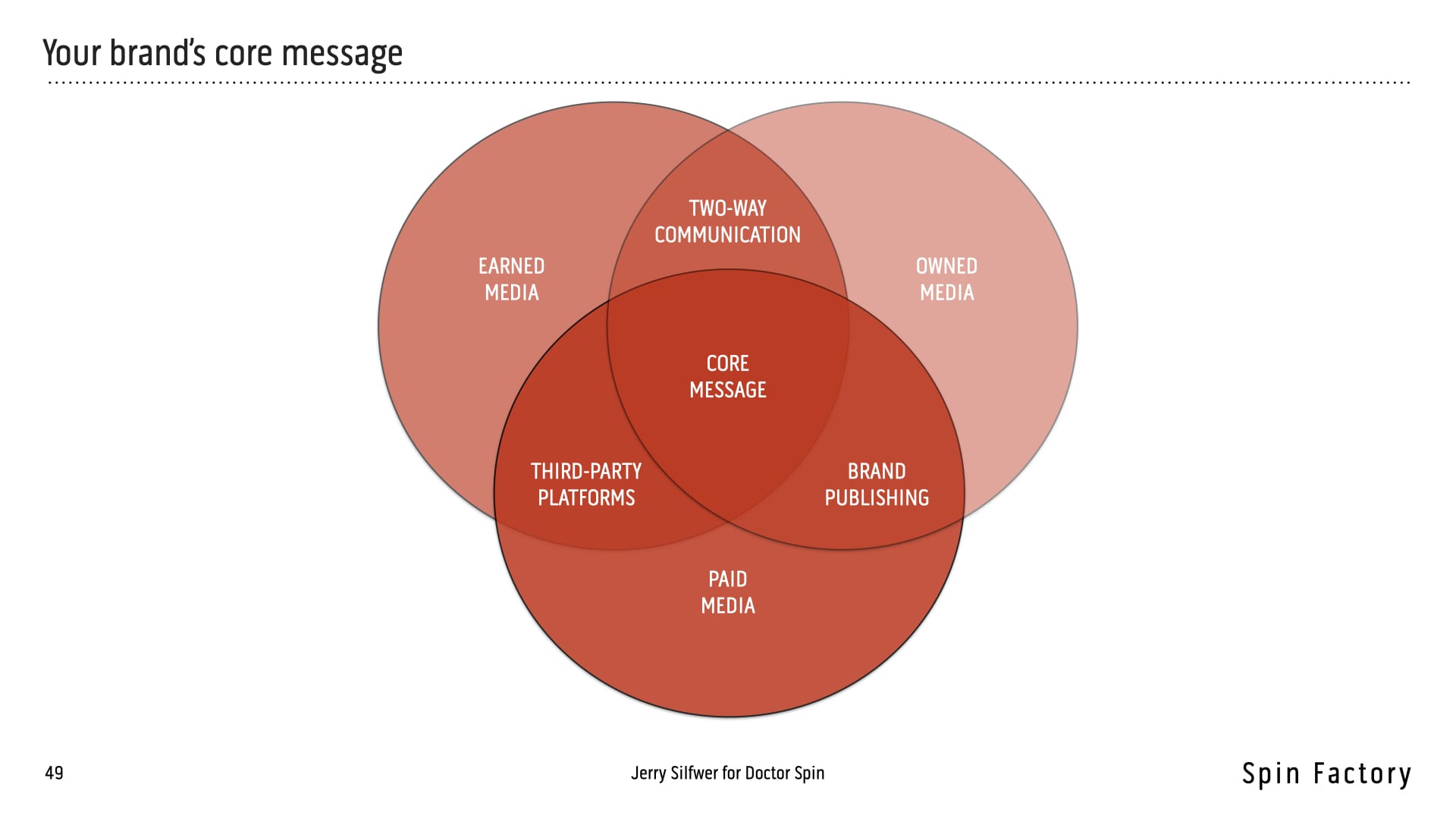C‑level executives must understand that PR, by nature, is a double-edged sword.
Disregarding the differences between PR and marketing is a lost opportunity at best.
The key to success is to appreciate the brand’s core message and hold the PR function accountable.
Many business leaders struggle with public relations. Free publicity, word-of-mouth, an excellent reputation, no insider threats — all of that sounds enticing, but PR can feel like a coin toss for most.
We define public relations might give you some idea, but it doesn’t explain the strategic approach.
What is Public Relations?
PR is often called Communications (or even Strategic communications) in many organisations.
In the corporate world, the PR function is often referred to as the ‘Communications Department,’ just as the advertising function is typically referred to as the ‘Marketing Department.’

Public relations professionals sometimes jokingly say that PR also stands for ‘Perception Management’ or ‘Personal Relationships.’
But—what is public relations?
The Public Relations Definition
The PR expert Rex F. Harlow once tried to gather all available definitions of public relations (PR), but he allegedly gave up after finding over 500+ different versions. 1From the early 1900s to 1976, Rex F. Harlow, a well-respected expert on public relations, gathered around 500 different definitions of public relations (Cutlip et al. 2006). 2Morris, T., & Goldsworthy, S. (2008). From PR to propaganda. 97 – 111. https://doi.org/10.1007/978 – 0‑230 – 59485-2_7
Amongst so many definitions of public relations, here’s the one that I find to be most useful:
Public relations (PR) = the strategic use of communication to establish and sustain productive brand relationships with publics, stakeholders, and influencers. 3Silfwer, J. (2015, November 7). What is Public Relations? Doctor Spin | The PR Blog. https://doctorspin.net/what-is-public-relations/
Please note:
Publics = psychographic segments (who) with similar communication behaviours (how) formed around specific issues (why) impacting a brand (to whom). 4Silfwer, J. (2015, June 11). The Publics in Public Relations. Doctor Spin | The PR Blog. https://doctorspin.net/publics-in-public-relations/
Stakeholders = representatives of various vested interests directly or indirectly connected to a brand. 5Silfwer, J. (2021, January 5). The Stakeholders in Public Relations. Doctor Spin | The PR Blog. https://doctorspin.net/stakeholders-in-public-relations/
Influencers = independent content creators with influential platforms and followings of potential importance to a brand. 6Silfwer, J. (2020, January 15). The Influencers in Public Relations. Doctor Spin | The PR Blog. https://doctorspin.net/influencers-in-public-relations/
Learn more: Public Relations Definition
One of the first things I tell leaders is that while we could use PR to move perceptions, the best strategy is to amplify your strengths. To illustrate this, I use Treacy and Wiersema’s value disciplines.
Each direction in the model comes with operational and cultural choices that separate your trajectory from the other approaches.
The gist of the model is that maximising value comes at a cost; the successful brand must choose between striving for product leadership, operational excellence, or customer intimacy.
You fall on your sword if you’re doing PR in all directions.
Apple is an excellent example of product leadership and communication; their PR activities aren’t geared towards being a cheap alternative or discussing their roadmap with their biggest fans. Apple’s PR is all about product leadership — and little else.
Any PR strategy should be subservient to what your business is all about.
I’m sure there are tons of creative PR ideas for Apple in the direction of “best total cost” and “best total solution”, but Apple’s executives must be relentless in shooting such initiatives down. Because even if such ideas produced results on the campaign level, they would detract from the brand’s total value strategy.
So, how do you manage the overall direction of your brand’s PR activities?
The most common failure in C‑level management is to mistake PR for marketing. The purpose of marketing is to drive sales, while the goal of PR is to manage relationships.
“What gets measured gets done,” and this is sometimes unfortunate.
Many C‑level executives are tasking their PR functions to focus on marketing KPIs, and as a result, many organisations are leaving strategic communication to chance. This is also why a relatively small subset of businesses, those who are getting their PR strategy just right, can soar high above their competition in the marketplace.
Each brand only gets one cognitive claim in an abundant world of information. Not two, or three, or four.
Red Bull, for instance, has chosen to focus on action sports that send people flying through the air. Since they want that specific spot and relationship with their community, they don’t focus any communication activities on anything else.
The key to managing PR is understanding communication’s importance in building and maintaining relationships.
Not even your best customers are to be seen as quantifiable, deal-seeking, and distractible wallets with legs. They don’t like to be seen or talked to this way; no one does.
As a C‑level executive, you should push your PR function to focus not on specific KPIs (like sales, churn, or acquisition) but towards one (because that’s all you get) core message.
To maximise the perceived value of your business, we must focus all communication efforts on dominating that one spot in the human mind.
Here in the West, for example, online retailer Amazon is so giant that they could be a great many things to many people, but they have wisely chosen to push for just one thing, “We are the everything store.”
One example of core messaging would be Rolex. They used to have one of the most engaging fan pages on Facebook, focusing solely on what their brand community loved — their grand heritage and craftsmanship.
But lately, they’re focusing on sponsoring athletes, collaborating with filmmakers, and showcasing new watch models.
Today, their engagement levels are nowhere near what they used to be. Rolex is discussing what market research suggests a younger audience with money to spend would like to see and hear.
To see the world through the lens of PR is to see the world differently.
At the same time, marketers see opportunities for increasing sales everywhere, which is good. PR sees the various stakeholders your business depends upon. 7This is where most C‑level executives get surprised; I’m typically asked for help with influencers, journalists, and social followers. However, many executives are often surprised when I suggest … Continue reading
From a PR perspective, your business is surrounded by customers, journalists, and various stakeholders.

We must constantly manage stakeholder perceptions to ensure your organisation can focus on its business objectives.
This is also where digital marketing professionals tend to suggest activities that might be too narrow for maximising the overall value creation of your business. They’re often sharply focused on increasing conversion through each step of a marketing funnel and not at all concerned about the behaviours of smaller subsets like investors, influencers, journalists, and antagonists — whose overall influence on conversion often surpasses that of online majority behaviours.
Summary for C‑level Executives
Clarify your brand’s value direction and demand that the PR function is 100% onboard. Otherwise, replace your PR function immediately.
Ensure that all PR activities revolve around a simple and inspiring core message. Push your PR function to repeatedly communicate this core message in new and creative ways to all key publics.
Don’t mistake PR for marketing and measure messaging instead of sales. When discussing goal-setting and strategies with PR professionals, discuss the perspective of different stakeholders instead of target audiences.

THANKS FOR READING.
Need PR help? Hire me here.

Annotations
| 1 | From the early 1900s to 1976, Rex F. Harlow, a well-respected expert on public relations, gathered around 500 different definitions of public relations (Cutlip et al. 2006). |
|---|---|
| 2 | Morris, T., & Goldsworthy, S. (2008). From PR to propaganda. 97 – 111. https://doi.org/10.1007/978 – 0‑230 – 59485-2_7 |
| 3 | Silfwer, J. (2015, November 7). What is Public Relations? Doctor Spin | The PR Blog. https://doctorspin.net/what-is-public-relations/ |
| 4 | Silfwer, J. (2015, June 11). The Publics in Public Relations. Doctor Spin | The PR Blog. https://doctorspin.net/publics-in-public-relations/ |
| 5 | Silfwer, J. (2021, January 5). The Stakeholders in Public Relations. Doctor Spin | The PR Blog. https://doctorspin.net/stakeholders-in-public-relations/ |
| 6 | Silfwer, J. (2020, January 15). The Influencers in Public Relations. Doctor Spin | The PR Blog. https://doctorspin.net/influencers-in-public-relations/ |
| 7 | This is where most C‑level executives get surprised; I’m typically asked for help with influencers, journalists, and social followers. However, many executives are often surprised when I suggest practical PR activities for policy-makers, legislators, employees, investors, and society. |




